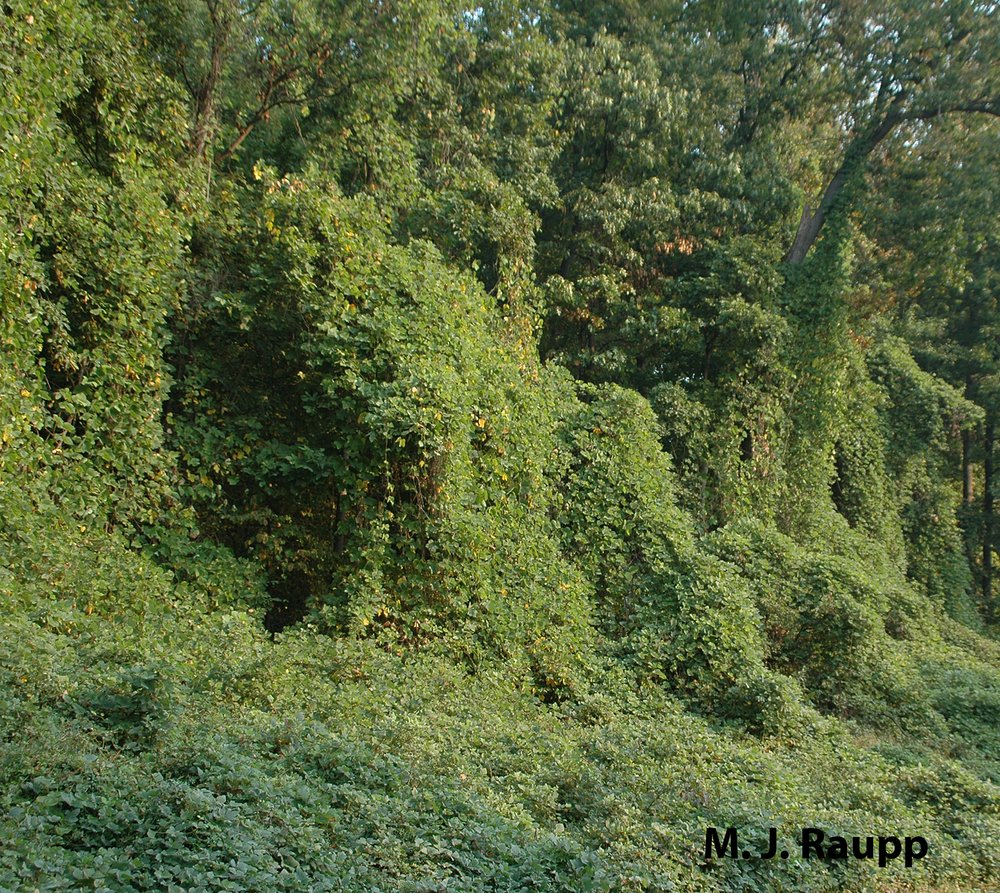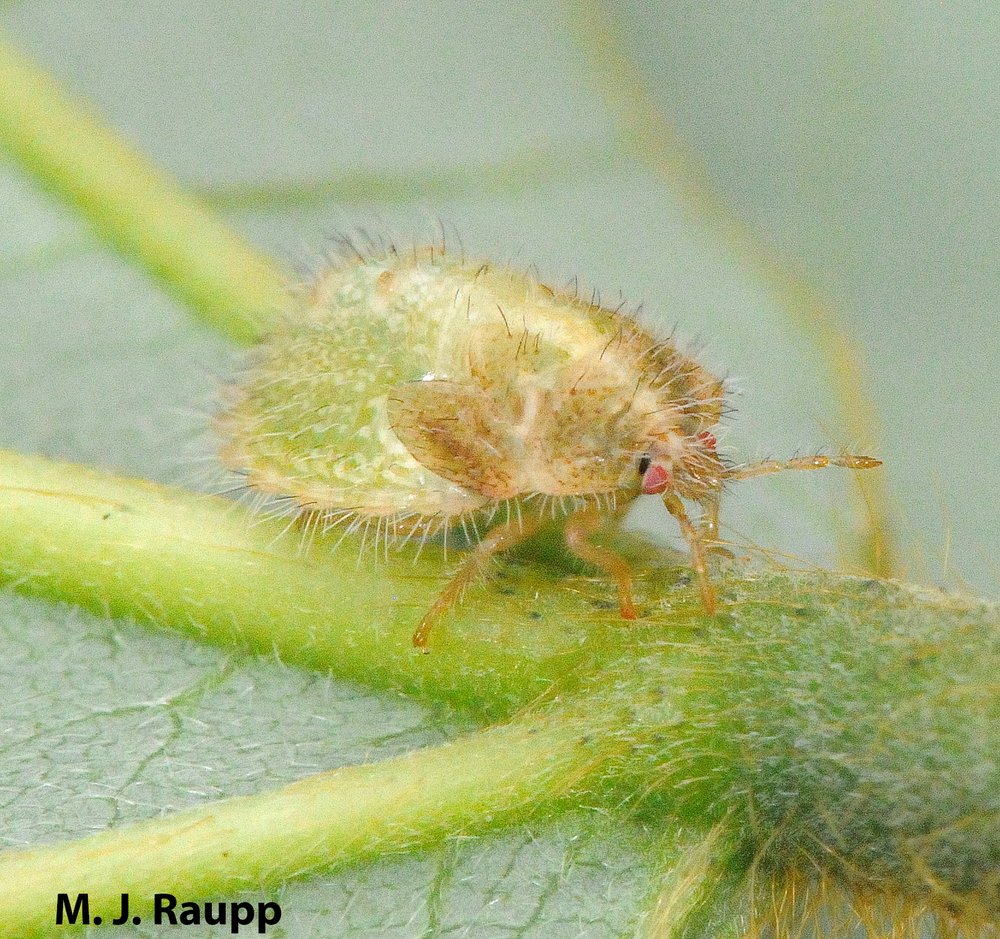From the mailbag: Fig-eating Kudzu bugs come to college, Megacopta cribraria

A small cluster of kudzu bugs feed on a branch near the base of a developing ‘Sicilian Dark’ figs. Image credit: Sam Bahr

Highly invasive kudzu can engulf native vegetation and wreak havoc on ecosystems.
Last week we received a report from the University of Maryland’s eagle-eyed horticulturalist, Sam, that ‘Sicilian Dark’ figs were supporting a tiny herd of kudzu bugs. The presence of these rascals in College Park was not surprising, as the bug is known from more than a dozen counties in the DMV and in major cities including Baltimore and the District of Columbia. What is surprising is the bug’s use of figs as a source of food. Here is the backstory. This tale begins not with the bug itself, but with one of its favorite host plants, nefarious kudzu, often called ‘the vine that ate the south’. This invasive plant was first introduced to the United States at the Centennial Exposition in Philadelphia in 1876. Selected for its ornamental value, it once adorned the Japanese House in Fairmount Park, PA. Its ability to fix nitrogen, tolerate drought, serve as forage for livestock, and reduce soil erosion made it a popular choice for planting during the Dust Bowl years and its range in the US expanded dramatically. Kudzu cares nothing about blue or red states and it is now found coast to coast and border to border.

Nymphs of kudzu bugs are almost as hairy as the vines of kudzu on which they feed.
In Asia, kudzu serves as one of the favorite hosts for many species of insects, including the nefarious kudzu bug, and careful inspections of imports and lady luck barred entry of this insect to North America. This changed in 2009 when kudzu bug was discovered near Atlanta, Georgia. How it arrived in the US is anyone’s guess, but like its cousin the brown marmorated stink bug, the kudzu bug is a good hitchhiker and it may have arrived as a stowaway in a cargo shipment from its aboriginal home in Asia. In just three years, the bug moved from Georgia to nearby states of Alabama, Florida, Mississippi, North Carolina, South Carolina, Tennessee, and Virginia. Some eleven years ago, Dr. Bill Lamp and the intrepid members of his laboratory discovered the bug in patches of kudzu in Anne Arundel, Calvert, Charles, Prince George’s, and St. Mary’s counties in Maryland.
As a foodie fond of invasive kudzu, some might herald the arrival of the bug as a blessing, but this bug has a darker side. In addition to kudzu, one of Maryland’s most important crops, soybean, is also on the menu. This bug favors several members of the bean family but has been found on several unrelated species in at least eight other plant families. Soybean growers in infested states have reported important losses associated with kudzu bug. This critter has sucking mouthparts that, once inserted into the leaves and stems, pump methodically to rob the soybean of its nutritious sap. The removal of these vital fluids can significantly reduce yields.
Meet kudzu, the vine that ate the south, overrunning a landscape in Maryland. Shiny kudzu bug adults and hairy kudzu bug nymphs dine with gusto on its leaves. Look closely at this small branch on a fig tree. See the bumps. This spring tiny herds of kudzu bugs made a surprise visit to the University of Maryland where they dined on plantings of ornamental figs.

Kudzu bugs are kind of cute.
Like its cousin the brown marmorated stink bug, kudzu bug is a stinky home invader. Stinky, you bet. While collecting kudzu bugs, I learned that it does not take much for these little guys to release their pungent defensive odor. Dramatic pictures from southern states show sides of homes festooned with thousands of kudzu bugs seeking overwintering refuge in the autumn. In nature, winter refuge is usually provided by plant debris in the field or beneath loose bark of trees, however, where human-made structures adjoin soybean fields, prepare for an invasion. After passing the winter in protected locations, adults emerge in spring and move to soybeans and other plants, where they mate and deposit ranks of barrel shaped eggs on the undersides of leaves. Eggs hatch and hairy greenish-yellow nymphs feed on plant sap for several weeks before molting to the adult stage. These adults lay eggs and the cycle is repeated, however, the ensuing adults are the ones that seek overwintering refuge in autumn. Adding insult to injury, defensive secretions of kudzu bugs can stain fabric, walls, and skin and may cause skin irritations including blisters to sensitive people.
Circling back to the bugs attacking figs, well, kudzu bug has been also been reported on mulberry. And guess what, like mulberry, fig is also a member of the Moraceae plant family. So, perhaps kudzu bug’s arrival on Sicilian Dark figs is not all that strange. In this time of global change and with the advent of global trade over the past several decades, we should be prepared to meet other warm weather visitors from afar like the stinky kudzu bug.
Acknowledgements
Bug of the Week thanks Sam Bahr for sharing images of kudzu bugs and inspiring this episode. The articles “A New Invasive Species in Maryland: The Biology and Distribution of Kudzu Bug, Megacopta cribraria (Fabricius) (Heteroptera: Plataspidae)” by A. W. Leslie, C. Sargent, W. E. Steiner, Jr., W. O. Lamp, J. M. Swearingen, B. B. Pagac, Jr., G. L. Williams, and M. J. Raupp and “Bean Plataspid: Megacopta cribraria (Fabricius) (Insecta: Hemiptera: Heteroptera: Plataspidae)” by Ashley Poplin and Amanda Hodges provided valuable insights into this pest.
This post appeared first on Bug of the Week